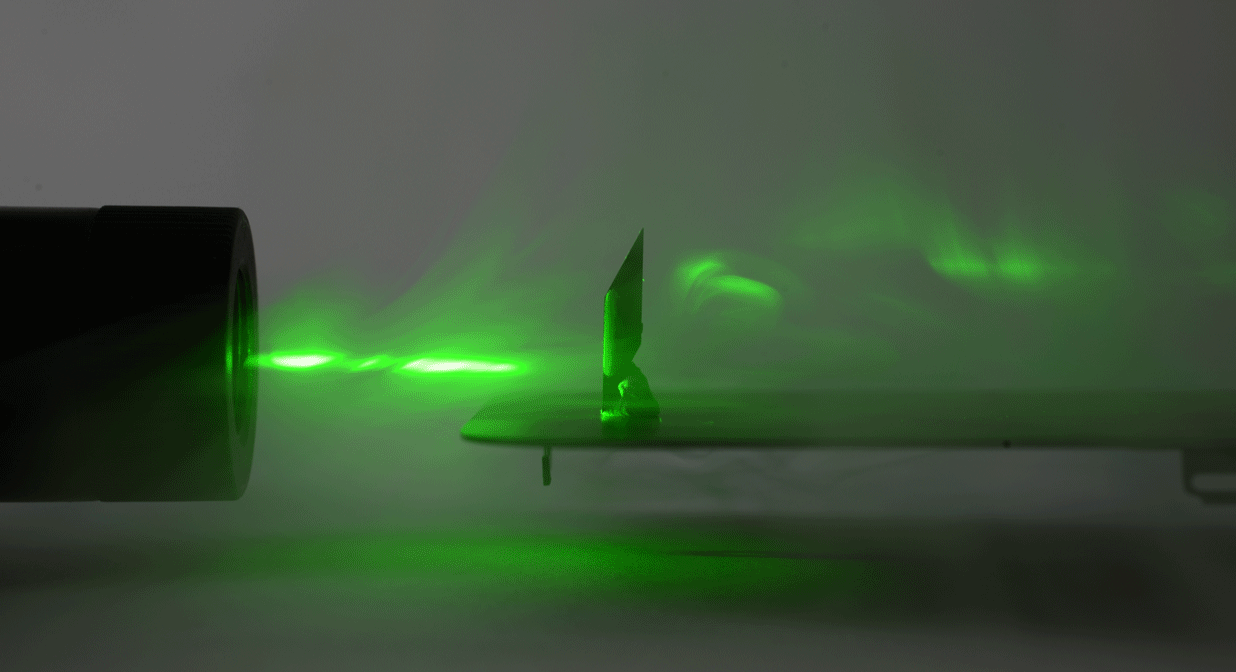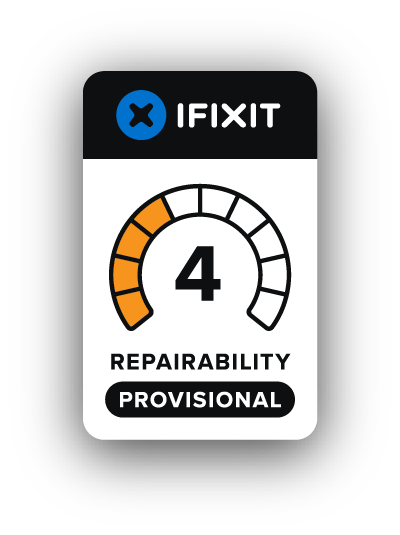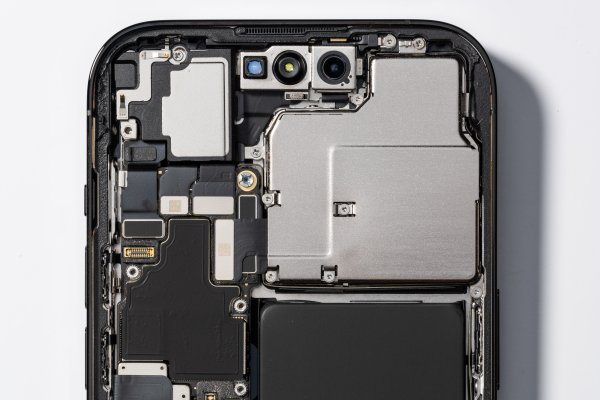iPhone 15 is here, and it boasts a new charge port, a titanium frame, a periscope, and a new pro-repair design. Let’s dive inside! We’re going to focus on the 15 Pro Max, with some cameos from the other phone models.
Design Architecture
For years, smartphones have either opened from the front–making battery swaps difficult, or from the back–making screen swaps challenging. Apple finally cracked this nut with last year’s vanilla iPhone 14, enabling the phone to open from the front and the back. This huge upgrade led us to ratchet up the iPhone’s repairability score from previous models. (We’ve since ratcheted it back down due to repair limitations imposed by parts pairing, but that’s another story.)

The iPhone 15 and 15 Plus thankfully adopt the iPhone 14’s advancement. There’s a central chassis, or midframe, that the internal components are mounted to. The 15 Pro and Pro Max also now open from both directions, but in an unexpectedly opposite manner: all of the internals are hiding behind the screen still instead of behind the back glass. But that back glass is now removable, too, just like the 14.
This notable achievement is worth celebrating. For the first time, Apple’s keynote discussed repairability:
There is also a new internal chassis architecture that makes iPhone more repairable, thanks to a new structural frame that allows the back glass to be easily replaced.
This inverted chassis arrangement makes critical repairs like battery swaps slightly riskier than on the 14, because you’re removing the expensive, fragile display rather than an inert sheet of glass.

In order to get to the battery and other components you have to heat and pry open the screen, which is slightly riskier. If you accidentally tear a cable, it’s better to tear the back cover cable than it is to ruin the display.
The nod goes to the 14 for being slightly more risk-tolerant, but they’re both good designs. Why didn’t the 15 Pro adopt the 14’s design? We’re not sure. It may have to do with the larger camera array. The cameras protrude through a cutout in the aluminum midframe, and it’s possible there wasn’t enough room for the opposite arrangement.

Apple has continued to incrementally reduce the thickness of the display bezel.
Some have reported that the white gasket on the perimeter of the display is new, but it’s not–it’s just changed from black to white. The design is a little different than previous phones, and some have reported that it’s more difficult to remove.

On the base iPhone 15 models, Apple is now performing microphone repairs in their service centers. This is enabled by increased modularity, where the microphone is now a separate component.
Finally: USB-C
Notorious for charting their own course, convincing Apple to change direction takes a monumental amount of pressure. Our Right to Repair advocacy has already applied some such pressure, and Apple’s now selling service parts and posting repair manuals. But even we couldn’t convince them to switch to a standard port—it took the European Parliament to force that particular change.

And now everyone can reap the benefits! In addition to obvious compatibility advantages, the new USB-C port can provide 4.5 watts of power to external devices. That’s a massive 15x upgrade over previous Lightning phones, which can only output 0.3 watts.

Going into this release, there were two rumors floating around about the charge port. The first was that the part would be serialized, pairing it to the main board and locking out independent repairs. Fortunately, this is not the case, and swapping two ports maintains full functionality. Phew!
The second rumor was that Apple would limit the throughput of the USB-C port for some reason. That rumor turned out to be unfounded. The A17 System-on-Chip (SoC) adds a USB 3 controller, enabling USB 3.2 Gen 2 10 Gb throughput. Because the non-Pro iPhone 15 models inherited the older A16 Bionic, they only support USB 2 and are limited to the same transfer speeds as previous devices with Lightning.
The battery in the 15 Pro Max is 4422 mAh, an incremental 2.3% increase over the 14 Pro Max’s 4323 mAh pack. Similarly, the 15 Pro has an identical 2.3% 3274 mAh (2.3% increase) over the 14 Pro’s 3200 mAh. This isn’t a good year for anemic battery capacity gains, because the A17 Pro is power-thirsty. Early reports are that the phone gets hot and stays hot, with a corresponding drop in battery life.

The battery is serviceable only by a trained technician. Fortunately, you can be a trained technician! Simply train yourself using Apple’s service manual (likely coming soon) or iFixit’s repair guides (in progress!). It’s not all that hard, we’ve helped millions of people fix their electronics themselves.
A Titanium Housing
The new Pro Max weighs 221 grams, 19 grams less than the 14 Pro Max. How much would you spend to save 19 grams? Pick up four nickels. What’s it worth to you to shave that much weight off of your phone? Well if you’re Apple, the answer is a heck of a lot.

The single largest use of metal in the iPhone is in the outer frame, so that’s where Apple turned to advanced metallurgy to save some grams and gain some marketing points.
One interesting theory that has been floated about the reduced weight is that by shaving weight around the perimeter of the phone, it feels easier to move around. The technical term for this is moment of inertia, or how much force it takes to rotate the phone around its axes. As mass is removed from the edges, the phone feels more nimble in your hand—like tucking your legs in while spinning. Where Apple is removing the weight is a larger contributor to the “feel” than the actual 9% weight reduction.
“Reducing the mass at the perimeter, which the change from stainless steel to titanium has done, has definitely reduced the moment of inertia more than a uniform reduction in mass would have. And that will make the 15 Pro easier to manipulate and will contribute—at least somewhat—to the impression of lightness.”
Dr. Drang
Titanium is a space-grade material, used in situations where you’re willing to spend a lot of money for extra tough and lightweight materials. The titanium used in the super-fast SR-71 Blackbird reconnaissance aircraft famously came from the unwitting Soviet Union. Way back in 2001, Apple made the PowerBook G4 out of titanium. We were particularly fond of this workhorse, which encased the display in painted titanium.
Manufacturers tend to avoid titanium if at all possible, not just because it’s expensive but because it’s notoriously hard to work with.
So while titanium made sense for the outer shell, it didn’t make a difference for the midframe, a hidden yet mechanically complex aluminum part that all the inside phone components mount to. But how do you keep the aluminum midframe and use titanium for the perimeter?
Using an industry-first thermo-mechanical process, the titanium bands encase a new substructure made from 100 percent recycled aluminum, bonding these two metals with incredible strength through solid-state diffusion. The aluminum frame helps with thermal dissipation and allows the back glass to be easily replaced.
That thermo-mechanical process is likely solid state diffusion bonding, a process where two different metals are heated really hot and then pressed together really hard. This isn’t a new idea–heating metals up and banging them together is how blacksmiths have worked for thousands of years. But these days, it’s quite rare. Wikipedia says, “Due to its relatively high cost, diffusion bonding is most often used for jobs either difficult or impossible to weld by other means.”
High cost? Super-hard metal? Difficult job? That sounds like something really up Apple’s alley.
This is approximately what a diffusion bonding machine looks like. It heats metals up to 1700 Celsius, or about the melting point of steel. And then it sucks all the oxygen out, creating a 10‐6 torr high vacuum. Then it presses the material together with 100 tons of force. And then you leave it there for an hour. Apple’s recipe won’t match this exactly, but if this reminds you of the process for making diamonds, you’re not far off.

That’s an insanely complicated, expensive process that is typically limited to small production aerospace parts, not mass production of smartphones. Whatever machine Apple is using, they have a lot of them.
There are sustainability implications here. Electronics recyclers are accustomed to working with steel and aluminum, but don’t usually deal with titanium. If the titanium ended up in an aluminum shredder, it would damage or dull the blades. On the other hand, iPhones have so much residual value that they generally get special treatment in these facilities.
While the titanium itself is very hard, the coating on the titanium scratches quite easily. Thanks to Evident Scientific for assistance with the imagery.
Electronics
One thing we were not expecting to find is an Apple baseband processor. Apple’s 5G modem team has been toiling in isolation for years without any hardware to show for it. We’re not sure who to feel for, Tim Cook’s wallet or the poor Apple lawyers who had to grovel with Qualcomm a new contract. Amazingly, the hundreds of engineers working on this project for first-Infineon, then-Intel, and now-Apple have yet to ship a single 5G modem to customers. That’s got to be demoralizing.

Sure enough, once we separated the main boards, we can confirm that Apple is using Qualcomm’s high end Snapdragon X70 modem. According to Qualcomm, it’s powered by AI for beam management and antenna tuning. AI and 5G? We’ve heard that before! Alas 8K is nowhere to be seen.

The Apple A17 Pro hexa-core applications processor with six-core GPU layered under what is likely SK Hynix DDR5 memory. We’ve created a separate Chip ID page with extreme detail on what all of those parts are.
This part is manufactured with TSMC’s cutting-edge 3nm process, and is unlikely to be beaten by anything else anytime soon as Apple simply bought out the entirety of TSMC’s capacity for the year. Rumors are that yield on this new process are still quite low, making this a particularly expensive part.
Cameras
The big upgrade for the cameras this year is the “tetraprism” periscope lens, upping the iPhone’s optical zoom from 2x to 5x. The S23 Ultra technically beats this with 10x zoom, but the way Apple’s engineers achieved it is particularly interesting. Tetraprism, a fancy way of saying four lenses, is a word invented by Apple’s marketing team, but it’s got a nice ring to it!

Instead of opting for a series of lens elements controlled by electromagnets, they designed a single element “periscope” which reflects light multiple times to simulate a 120mm focal length.

The physics challenge that smartphone camera designers are constantly working against is the thickness of the lens system. Using a periscope allows them to offset the sensor slightly from the lens.

A periscope is a device for viewing things past obstacles. In this case, the obstacle is the camera itself. The mirrors bounce the light to the side, allowing for a greater focal length between the front lens and the focusing point on the sensor.
Aside from the new periscope lens, the sensors on the 15 Pro Max main and wide cameras seem to be the same size as last year’s 14 Pro Max—suggesting any improvement in image quality has more to do with the new A17 SoC than the camera hardware itself.

One surprising thing we found was substantially larger screws holding down the camera than in the past. Why? We have no idea. But we have a new microscope, and this is as good a way as any to show it off!

A Great Design Undermined by Parts Pairing
Unfortunately, swapping the front camera between two of our 15 Pro Max units results in complete failure. The cameras simply do not work. When we first encountered this problem last year, where the part was paired to its original device, we assumed that it was a bug that would be quickly fixed. Our trust was clearly misplaced.
It’s time for an urgent conversation about Apple’s approach to repairability. Despite our enthusiasm for iPhone 14’s easier-to-disassemble design, we’ve been compelled to adjust our repairability score from a promising 7 to a discouraging 4, highlighting Apple’s ongoing constriction of repair freedoms through its restrictive parts pairing system. To effectively repair these models, you have to procure parts within Apple’s sphere and validate the repairs. Without calibration, the parts either don’t work at all, or have compromised functionality and incessant warnings.
Repair is hard enough without software obstacles thrown into the mix. We’ve spent over $10,000 on iPhones over the last few days and our technicians have been systematically testing components to determine which repairs are possible and which are not.
Our objective in methodically swapping out every component in the phone is to find out whether repairs will be impossible or simply annoying. Our tests swap parts between identical, brand new devices. No aftermarket parts are involved. We’ve discovered that the rear lidar assembly, which will be critical for augmented reality functionality and creating content for the Vision Pro, is completely locked to the iPhone 15 Pro Max.

We purchased two iPhone 15 Pro Max units, and swapped the lidar modules between the two. The camera app initially loaded and then crashed. We were able to repeatedly reproduce this behavior.
Here’s the result of our tests:

Parts pairing in these models extends beyond mere mechanical compatibility, requiring authentication and pairing through Apple’s System Configuration tool, further limiting genuine replacements to Apple-blessed ones and substantially impacting independent repair enterprises and the overarching issue of e-waste.
Our insights aren’t confined to iPhones; we’ve witnessed analogous situations with MacBooks and iPads where the stranglehold on repairability is tightening, restricting the remit of repairs to Apple or forcing compromises on independent repairs. The slew of software hindrances significantly overshadow any mechanical advancements in design.
That dystopian future that science fiction authors warned us was coming, where DRM infected every part of our lives? We’re living in it. The result of these extensive limitations is a major infringement of ownership rights and amplification of the e-waste crisis.
Repairability
The iPhone 15 Pro Max, 15 Pro, 15 Plus, and 15 all earn a four out of ten.

The score is provisional because we are awarding some credit for anticipated service manual availability and selling repair parts. Apple doesn’t have either of these live at the moment, but we expect them soon.
Unfortunately, software is the anchor around an otherwise exceptionally designed phone. But without the ability to swap components, repairability suffers dramatically. We don’t purchase products for our team that score below a five, so iFixit will not be purchasing the iPhone 15 for internal use.
The Bottom Line
The 15 is an incremental upgrade, and that’s just fine. The rollout of the 14’s innovative open-from-both-sides mechanical architecture is welcome. Investments in camera hardware are always well spent, and the periscope is particularly innovative. Given the expense, reduced drop test tolerance, recycling challenges, and fragile finish, titanium doesn’t seem like the best long-term material for a smartphone—but we’re impressed Apple pulled it off. We tip our hats at the materials engineers, but aluminum works just fine from our perspective.
It’s clearly time for Apple to abandon parts pairing. Some parts calibrations will need to be performed with tooling in the field, and some parts will simply need to be enabled without calibration or the same level of precision that Apple achieves in their factories. That’s perfectly acceptable for a field repair.
A part installed in a phone should just work. Ever since we invented interchangeable parts in the 1800s, parts have been swappable between products. Software shouldn’t be an obstacle to harvesting parts, or using aftermarket parts for that matter. The entire economy of reuse depends on interoperability, from local repair shops to large scale refurbishers to recyclers.
The iPhone is the market leader, but Apple is trailing the pack on repairability. This gap is completely self-inflicted, with a perfectly serviceable hardware design that is sabotaged by an incredibly complex regime of parts pairing and cloud calibrations.
It’s time for Apple to start thinking differently.

Wallpapers
Check out this page for nifty iPhone 15 teardown and X-ray wallpapers!









34 Comments
The Chip ID pages link doesn't seem to be working
Sean Davis - Reply
Thanks for catching that! It should be fixed now.
Arthur Shi -
I just wanna thank you for doing that work. Seems incredible to me that you write such an extensive article about repairability of devices. I really appreciate it and I do hope Apple will do better. Despite their anticompetitive behavior I always am drawn to their new products because I just like how they look and how the os works. Thanks for helping me getting a full picture
nicht_menschlich - Reply
What is the die size of A16 and A17 Pro?
Anonymous - Reply
Without part authentication, what is the answer for (a) reducing the resale value of stolen & locked iPhones to repair shops and (b) preventing advanced attacks in which a genuine part is substituted for a malicious part?
Runes Droid - Reply